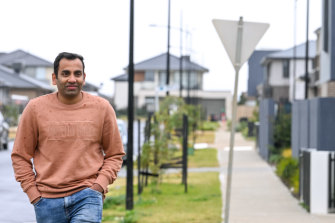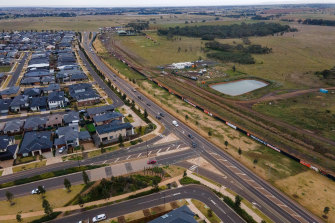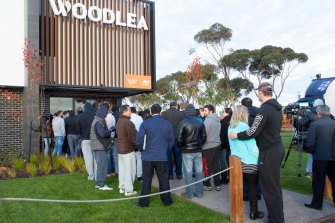Home » World News »
‘Land banking’ by big developers driving up property prices: report
Key points
- Think tank Prosper tracked 26,000 sales in nine master-planned communities including Woodlea Estate, Atherstone and Manor Lakes in Melbourne and found only 23.8 per cent of sites had been sold over an average of 9.5 years.
- Prices increased by an annual rate of 5.5 per cent above inflation, leaving home buyers paying an extra $194,000 for a typical site.
- Prosper found a handful of big property developers control swaths of land on Melbourne’s urban fringe and have effectively locked it up, releasing it at a time of their choosing to maximise profits.
The state government’s push to reduce the cost of housing by releasing swaths of land on Melbourne’s fringe is being undermined by big developers, which new economic analysis suggests are banking the land then releasing it slowly to maximise their profits.
A research report that analysed the past 10 years of land sales on the outskirts of Australia’s big cities has revealed the true cost to home buyers of “land banking” over that period was $5.9 billion nationwide.
Praveen Mandala bought his block in the Woodlea Estate when it launched in 2015 and says prices are now “shooting up”. He loves living in the development. Credit:Eddie Jim
The investigation by economic think tank Prosper Australia tracked 26,000 sales in nine master-planned communities, including three in Melbourne – Woodlea Estate, Atherstone and Manor Lakes, owned by developers Mirvac, Lendlease and the Dennis Family Corporation. The study found that over 9.5 years, only 23.8 per cent of sites released by government to these developers had been sold to home buyers.
Instead of land and housing prices falling as more land is opened up for development, prices increased by an annual rate of 5.5 per cent above inflation. This means families buying lots in these developments now are paying an average $194,000 more for a typical site than those who bought in at the early stages of the development.
Karl Fitzgerald, director of advocacy at Prosper Australia, said more than 110,000 approved sites had been released to developers nationally over the past decade, but only 26,000 sites, or fewer than a quarter, had been sold.
“The slower the sales, the more developers make,” he said. “We have been at this growth-at-all-costs mentality for a long time now and our report shows we could concrete over all of Victoria and still housing prices would increase because of the market power developers have to just halt supply at whim.”
Some developments took more than 40 years to complete, and across all the sites Prosper analysed, developments took more than twice the period of time promised at time of release to sell out.
Prosper is a think tank funded by a trust formed in 1928 to make the argument that the burden of taxation should move away from income and businesses and onto land and other finite resources.
Michael Buxton, emeritus professor of environment and planning at RMIT University, said land banking by developers had been a problem for decades.
“The government makes available a large amount of land in theory by rezoning and fast-tracking approvals … but the decision is then left to the development company about the rate at which this land supply will be made available. So a lot of them are drip-feeding land out in order to keep land prices high.”
A Victorian government spokeswoman said developers were expected to release land for housing after all planning processes had been completed.
“Increasing the supply of new homes is one of many factors that help drive down the cost of buying a home,” she said. “It is disappointing that developers continue to land bank and block the delivery of homes to manipulate the market for profit.”
At Woodlea on Melbourne’s western fringe, large areas sit empty, waiting to be sold. When blocks are released, typically 25 every month, buyers go online to snap them up. But despite the demand, no more blocks are available for eager buyers.
Praveen Mandala bought his block in the 711-hectare estate, 29 kilometres from Melbourne’s CBD, in 2015 shortly after Woodlea launched stage eight of the development. “There was absolutely nothing, just paddocks and a sales office,” he said.
An aerial view of the Woodlea Estate in Aintree on Melbourne’s western fringe. Credit:Eddie Jim
Mandala said people used to “queue up for days like an iPhone release” to buy a block at Woodlea, but the process then moved online with the release of lots each month.
He paid $330,000 for his 640-square-metre block but said since then “prices have shot up” and the cost was closer to $450,000 for a 448-square-metre block.
Mandala loves living at Woodlea and is worried rising prices and the challenge of securing a plot make it difficult for more people to move to the area.
“It’s not just affordability. You need to be lucky as well to get a piece of land.”
Land sales at Woodlea are controlled by the developers, property giant Mirvac and Malaysian group VIP. After launching in 2015 Woodlea was advertised as “Australia’s fastest-selling community” and the development was expected to run over 18 years until 2033.
However, more than six years in, Prosper’s analysis of all sales at Woodlea, as assessed by the Victorian Valuer-General and recorded by CoreLogic, reveals only 25.1 per cent, or 1652 out of 6584 lots, had been sold by July 2021.
A spokeswoman for Woodlea and Mirvac disputed these figures and said the development had sold about 60 per cent of new home sites and had about 700 home sites under construction.
“The average sales rate at Woodlea is above what is achieved at similar projects of this scale,” she said. “We aim to release new home sites as quickly as possible, but this is reliant on a number of factors including authority approvals, delivery of critical infrastructure and services, supply and labour capacity, as well as market demand.”
Queues in 2018 to inquire about buying land at Woodlea. Credit:Steve Pinirou
Prosper’s analysis of sales data from Atherstone in Melton South found that after nine years of development 69.51 per cent of lots remained and total price gain for an average lot was $123,907 during that time.
According to developer Lendlease, as of January this year, Atherstone had sold 63 per cent and settled 54 per cent of total residential lots. Anne Jolic, head of Victoria communities at Lendlease, said Atherstone was a “top-performing” community.
“We have brought forward the delivery of many lots year on year to meet the strong market demand, and to deliver more housing to meet Victoria’s critical supply shortage,” she said.
Prosper’s analysis of Manor Lakes near Werribee found that after 16 years of development 43.31 per cent of lots remained and the price gain for an average lot was $251,059.
Dennis Family, the developer of Manor Lakes, did not respond to a request for comment.
Peak developer industry body the Urban Development Institute of Australia said delays were not the fault of developers but were instead a result of the post-precinct structure plan approval process.
Chief executive Matthew Kandelaars said Prosper’s report was based on “flawed assumptions”.
“The industry wants to bring land to market, but from engineering approvals to water and utility connections, it is drowning in red tape,” he said. “We’ve pleaded to have these processes streamlined as a matter of urgency.”
However, Fitzgerald said all the projects Prosper analysed already had planning approval and any delay was the developers’ choice.
“Australia needs to consider third-market housing models such as community land trusts, which are housing developments with community and affordability at the forefront rather than shareholder responsibilities, alongside ‘good old property tax reform’. Developers are saying they can finish a master-plan community in 20 years but they are averaging about 40 years across our study,” he said.
“We need to slowly ratchet up land taxes so by the 10th and 15th year it becomes less and less profitable to hold real estate to ransom.”
The Morning Edition newsletter is our guide to the day’s most important and interesting stories, analysis and insights. Sign up here.
Most Viewed in National
From our partners
Source: Read Full Article





